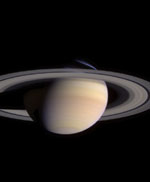
Image credit: CICLOPS
As Cassini closes in on Saturn, its view is growing sharper with time and now reveals new atmospheric features in the planet’s southern hemisphere.
The spacecraft’s narrow angle camera took several exposures on March 8, 2004 which have been combined to create this natural color image. The image contrast and colors have been slightly enhanced to aid visibility. The spacecraft was then 56.4 million kilometers (35 million miles) from Saturn, or slightly more than one-third of the distance from Earth to the Sun. The image scale is approximately 338 kilometers (210 miles) per pixel. The planet is 23 percent larger in this image than it appeared in the preceding color image, taken four weeks earlier.
Atmospheric features such as two small, faint dark spots, visible in the planet’s southern hemisphere, will become clearer in the coming months. The spots are located at 38 degrees South latitude.
Moons visible in the lower half of this image: Mimas (398 kilometers, 247 miles across) at left, just below the rings; Dione (1,118 kilometers, 695 miles across) at left, below Mimas; and Enceladus (499 kilometers, 310 miles across) at right. The moons have had their brightness enhanced to aid visibility.
The Cassini-Huygens mission is a cooperative project of NASA, the European Space Agency and the Italian Space Agency. The Jet Propulsion Laboratory, a division of the California Institute of Technology in Pasadena, manages the Cassini-Huygens mission for NASA’s Office of Space Science, Washington, D.C. The imaging team is based at the Space Science Institute, Boulder, Colorado.
For more information about the Cassini-Huygens mission, visit http://saturn.jpl.nasa.gov and the Cassini imaging team home page, http://ciclops.org.
Original Source: CICLOPS News Release
